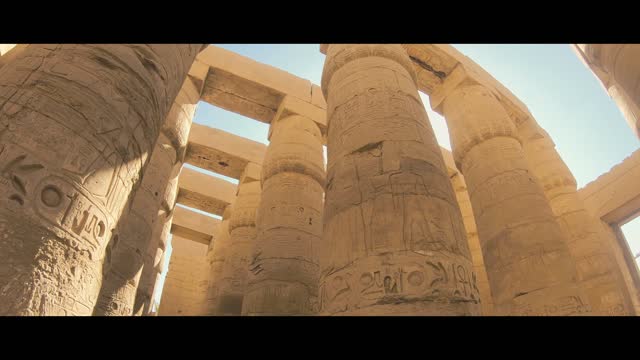Premium Only Content

pharaoh temple
pharaoh temple
Egyptian sanctuaries were worked for the authority love of the divine beings and in celebration of the pharaohs in old Egypt and locales under Egyptian control. Sanctuaries were viewed as houses for the divine beings or rulers to whom they were devoted. Inside them, the Egyptians played out an assortment of ceremonies, the focal elements of Egyptian religion: offering contributions to the divine beings, reenacting their legendary connections through celebrations, and warding off the powers of confusion. These customs were viewed as important for the divine beings to keep on maintaining maat, the heavenly request of the universe. Lodging and really focusing on the divine beings were the commitments of pharaohs, who subsequently committed immense assets to sanctuary development and upkeep. Due to legitimate need, pharaohs designated the majority of their ceremonial obligations to a large group of clerics, yet the greater part of the general population was barred from direct interest in services and illegal to enter a sanctuary's most hallowed regions. In any case, a sanctuary was a significant strict site for all classes of Egyptians, who went there to supplicate, give contributions, and look for ambiguous direction from the god abiding inside.
The main piece of the sanctuary was the asylum, which ordinarily contained a religion picture, a sculpture of its god. The rooms outside the safe-haven developed bigger and more intricate over the long haul, with the goal that sanctuaries advanced from little places of worship in late Prehistoric Egypt (late fourth thousand years BC) to huge stone buildings in the New Kingdom (c. 1550–1070 BC) and later. These buildings are among the biggest and most suffering instances of antiquated Egyptian design, with their components masterminded and finished by complex examples of strict imagery. Their average plan comprised of a progression of encased lobbies, open courts, and passageway arches adjusted along the way utilized for celebration parades. Past the sanctuary appropriate was an external divider encasing a wide assortment of auxiliary structures.
A huge sanctuary likewise claimed sizable lots of land and utilized large number of laymen to supply its necessities. Sanctuaries were accordingly key financial just as strict focuses. The clerics who dealt with these amazing foundations used impressive impact, and in spite of their apparent subjection to the lord, they may have presented huge difficulties to his power.
Sanctuary working in Egypt proceeded regardless of the country's decrease and extreme loss of autonomy to the Roman Empire in 30 BC. With the happening to Christianity, customary Egyptian religion confronted expanding abuse, and sanctuary factions vanished during the fourth through 6th hundreds of years AD. The structures they left behind endured hundreds of years of annihilation and disregard. Toward the beginning of the nineteenth century, a rush of interest in old Egypt cleared Europe, leading to the control of Egyptology and drawing expanding quantities of guests to the development's remaining parts. Many sanctuaries endure today, and some have become world-acclaimed vacation spots that contribute altogether to the advanced Egyptian economy. Egyptologists keep on examining the enduring sanctuaries and the remaining parts of annihilated ones as significant wellsprings of data about old Egyptian culture.
-
 0:22
0:22
kiranmad7
4 years agoTemple siva
47 -
 LIVE
LIVE
Lofi Girl
2 years agoSynthwave Radio 🌌 - beats to chill/game to
185 watching -
 42:55
42:55
Stephen Gardner
1 day ago🔥Trump’s SURPRISE Move STUNS Everyone - Democrats PANIC!
89.4K113 -
 1:37:19
1:37:19
Badlands Media
14 hours agoBaseless Conspiracies Ep. 148: The Delphi Murders – Secrets, Setups, and Cover-Ups
37.7K15 -
 5:59:05
5:59:05
SpartakusLIVE
8 hours ago#1 MACHINE Never Stops The GRIND || LAST Stream UNTIL Friday
142K2 -
 28:36
28:36
Afshin Rattansi's Going Underground
1 day agoDoug Bandow: ENORMOUS DAMAGE Done to US’ Reputation Over Gaza, Trump ‘Easily Manipulated’ by Israel
25.7K29 -
 2:45:13
2:45:13
Barry Cunningham
15 hours agoCBS CAUGHT AGAIN! CHICAGO A MESS! LISA COOK IS COOKED AND MORE LABOR DAY NEWS!
108K50 -
 6:39:17
6:39:17
StevieTLIVE
9 hours agoMASSIVE Warzone Wins on Labor Day w/ Spartakus
30.6K1 -
 10:46:42
10:46:42
Rallied
15 hours ago $17.67 earnedWarzone Challenges w/ Doc & Bob
200K4 -
 3:26:25
3:26:25
Joe Donuts Live
8 hours ago🟢 Lost in Space with My Clones: The Alters Adventure Begins
37.1K5